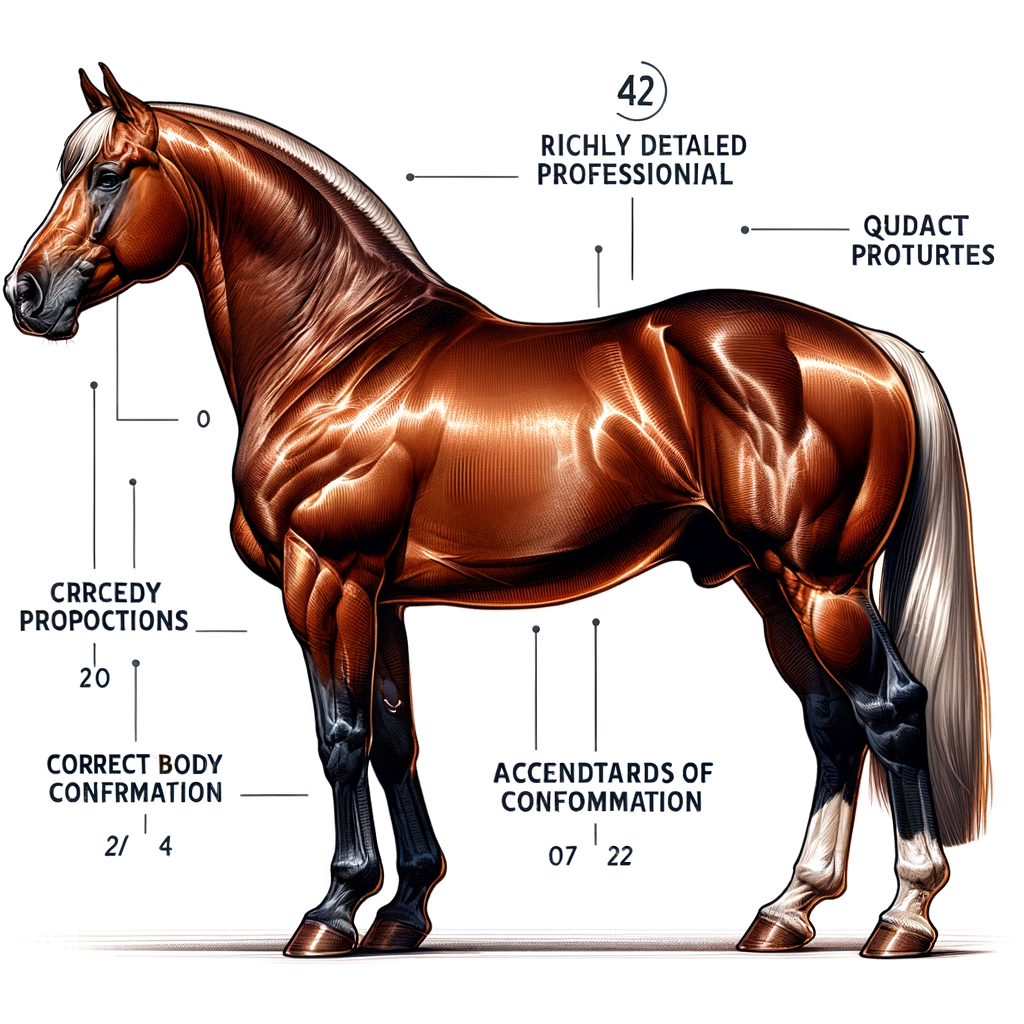
Understanding Horse Standards: An Overview
When it comes to horses, there are certain standards that are crucial to understand. These standards play a significant role in various aspects of horse care, breeding, and selection. Let’s delve into the importance of understanding these standards and their role in the world of horses.
- Importance of understanding horse standards
Understanding horse standards is essential for anyone involved in horse care, breeding, or selection. These standards provide a guideline for what is considered normal and healthy in a horse. They help in assessing the horse’s overall health, physical condition, and suitability for specific tasks or sports.
For instance, if you’re a horse breeder, understanding these standards can help you select the best horses for breeding. It can also assist in identifying any potential health or conformation issues that could affect the horse’s performance or well-being.
Moreover, these standards are not just important for professionals in the horse industry. Even if you’re a horse owner or a horse lover, understanding these standards can help you better care for your horse and ensure its health and happiness.
- Role of horse standards in breeding and selection
Horse standards play a pivotal role in the breeding and selection process. They provide a benchmark for breeders to select the best horses for breeding. This is not just about the horse’s physical attributes but also about their health and genetic traits.
For example, a horse with a strong, well-built body and good conformation would be considered a good candidate for breeding. On the other hand, a horse with health issues or poor conformation would not be ideal for breeding, as these traits could be passed on to the offspring.
Furthermore, these standards help in selecting horses for specific tasks or sports. For instance, a horse with a strong, muscular body and good stamina would be ideal for endurance riding, while a horse with a compact, agile body would be better suited for show jumping.
In conclusion, understanding horse standards is crucial for anyone involved in the horse industry. It helps in assessing the horse’s health and physical condition, selecting the best horses for breeding, and ensuring the horse’s well-being and performance.
Key Aspects of Horse Conformation
Understanding horse conformation involves taking a closer look at the physical characteristics of the horse. These characteristics can provide important insights into the horse’s health, performance, and suitability for various tasks.
Physical Characteristics
Physical characteristics are the visible traits that make each horse unique. They include size and weight, body type, and coat color and markings. Let’s delve into these key aspects:
- Size and Weight
- Body Type
- Coat Color and Markings
Horses come in a variety of sizes, from the small Miniature Horse, which stands at about 34-38 inches tall and weighs around 150-350 pounds, to the large Draft Horse, which can stand over 68 inches tall and weigh up to 2000 pounds. The size and weight of a horse can influence its strength, speed, and stamina.
The body type of a horse is largely determined by its breed. For instance, Thoroughbreds typically have a lean and athletic build, which makes them excellent racehorses. On the other hand, Draft Horses have a robust and muscular build, making them ideal for heavy work. Understanding a horse’s body type can help determine its suitability for specific tasks or sports.
The coat color and markings of a horse are another important aspect of its conformation. Horses come in a wide range of colors, including bay, black, chestnut, and white, and may have unique markings such as stars, stripes, or spots. While these characteristics are primarily aesthetic, they can sometimes provide clues about a horse’s breed or lineage.
In conclusion, understanding the physical characteristics of a horse is a key aspect of horse conformation. By examining a horse’s size and weight, body type, and coat color and markings, we can gain valuable insights into its health, performance, and suitability for various tasks.
Functional Characteristics
When we talk about horse conformation, we must not overlook the functional characteristics. These characteristics are equally important as they directly impact the horse’s performance and overall health. Let’s delve into these features:
- Movement and Gait
The way a horse moves is a critical aspect of its functional characteristics. The movement and gait of a horse can tell us a lot about its health and potential abilities. For instance, a horse with a smooth and balanced gait is likely to perform better in various activities such as racing, jumping, or dressage. On the other hand, a horse with an uneven gait may face difficulties in performing these tasks efficiently.
- Temperament
Temperament is another essential functional characteristic of a horse. It refers to the horse’s behavior and personality. Some horses are calm and easy-going, making them suitable for beginners or children. Others may be more energetic and spirited, requiring an experienced rider. Understanding a horse’s temperament is crucial for ensuring a good match between the horse and its rider.
- Health and Longevity
The health and longevity of a horse are directly linked to its conformation. A horse with good conformation is likely to have fewer health issues and a longer lifespan. For instance, a horse with a well-balanced body and strong legs is less likely to suffer from joint problems. On the other hand, a horse with poor conformation may face various health challenges, reducing its lifespan.
| Functional Characteristics | Description |
|---|---|
| Movement and Gait | Refers to the horse’s movement style, which can indicate its health and potential abilities. |
| Temperament | Refers to the horse’s behavior and personality, which can determine its suitability for different riders. |
| Health and Longevity | Related to the horse’s overall health and lifespan, which are influenced by its conformation. |
In conclusion, understanding the functional characteristics of a horse is vital for assessing its performance, health, and suitability for different riders. By considering these factors, we can make informed decisions when choosing a horse for various activities.
Understanding Quarter Horse Conformation
When it comes to horse breeds, the Quarter Horse stands out with its unique characteristics and conformation. Let’s delve into the distinctive features that make this breed truly remarkable.
Quarter Horse Characteristics
The Quarter Horse breed is known for its distinctive head and neck, compact body, and powerful hindquarters. These features contribute to its strength, agility, and speed, making it a popular choice for various equestrian activities.
- Distinctive Head and Neck: The Quarter Horse has a refined head with a broad forehead, expressive eyes, and a straight profile. Its neck is muscular yet flexible, allowing for a wide range of motion. This characteristic makes it ideal for tasks that require quick and precise movements.
- Compact Body: The Quarter Horse has a short, compact body with a deep chest and well-sprung ribs. This compactness contributes to its strength and endurance. Despite its compact size, the Quarter Horse is capable of carrying heavy loads and performing strenuous tasks.
- Powerful Hindquarters: One of the most notable features of the Quarter Horse is its powerful hindquarters. These muscular hindquarters provide the horse with exceptional speed and acceleration, especially over short distances. This is why the Quarter Horse excels in events like barrel racing and reining.
Understanding the Quarter Horse’s conformation is crucial for breeders, trainers, and horse enthusiasts alike. It allows them to assess a horse’s potential for specific tasks or sports, and to ensure the horse’s well-being and longevity.
Quarter Horse Standards
When it comes to Quarter Horses, there are certain standards that breeders and enthusiasts look for. These standards include height and weight, preferred body type, and desirable temperament. Let’s delve into these aspects in more detail.
- Height and Weight
- Preferred Body Type
- Desirable Temperament
Quarter Horses typically stand between 14.3 and 16 hands high, which is approximately 57 to 64 inches from the ground to the horse’s withers. As for weight, they usually range from 950 to 1,200 pounds. However, these measurements can vary depending on the horse’s diet, exercise routine, and genetic factors.
The ideal body type for a Quarter Horse is well-muscled and compact. They should have a broad chest, a strong back, and powerful hindquarters. The horse’s legs should be sturdy and well-proportioned to the rest of its body. This body type allows the Quarter Horse to excel in short-distance sprints, hence their name.
Quarter Horses are known for their calm and steady temperament. They are typically easy-going, friendly, and intelligent, making them excellent companions for both experienced riders and beginners. They are also known for their versatility, being able to adapt to various riding styles and disciplines.
In conclusion, when assessing a Quarter Horse, it’s important to consider their height and weight, body type, and temperament. These standards not only ensure the health and well-being of the horse but also contribute to their performance in various equestrian activities.
Horse Conformation Standards: A Comparative Study
When it comes to horse conformation standards, it’s important to understand the differences between various breeds. In this section, we’ll compare the Quarter Horse and the Thoroughbred, two popular breeds with distinct characteristics.
Quarter Horse vs Thoroughbred
Let’s delve into the comparison of the Quarter Horse and the Thoroughbred in terms of size and weight, body type, and temperament.
- Size and Weight Comparison
- Body Type Comparison
- Temperament Comparison
The Quarter Horse typically stands between 14.3 and 16 hands high and weighs between 950 and 1,200 pounds. On the other hand, the Thoroughbred generally stands taller, between 15.2 and 17 hands high, and weighs between 1,000 and 1,200 pounds.
The Quarter Horse is known for its compact, muscular body, broad chest, and powerful hindquarters, making it ideal for short-distance sprinting and work activities. The Thoroughbred, however, has a leaner and more athletic body, long legs, and a deep chest, which contributes to its exceptional speed and endurance in long-distance races.
Quarter Horses are often praised for their calm and steady temperament, making them excellent for beginners and children. Thoroughbreds, while intelligent and sensitive, are more spirited and energetic, requiring an experienced handler.
In conclusion, while both the Quarter Horse and the Thoroughbred have their unique strengths and characteristics, the choice between the two ultimately depends on the specific needs and experience level of the handler.
| Aspect | Quarter Horse | Thoroughbred |
|---|---|---|
| Size | 14.3-16 hands | 15.2-17 hands |
| Weight | 950-1,200 lbs | 1,000-1,200 lbs |
| Body Type | Compact and muscular | Lean and athletic |
| Temperament | Calm and steady | Spirited and energetic |
Quarter Horse vs Arabian
Let’s dive into the comparison between two popular breeds: the Quarter Horse and the Arabian. We’ll examine their size and weight, body type, and temperament.
- Size and Weight Comparison
- Body Type Comparison
- Temperament Comparison
The Quarter Horse and the Arabian have distinct differences when it comes to size and weight. The Quarter Horse typically stands between 14.3 and 16 hands high and weighs between 950 and 1,200 pounds. On the other hand, the Arabian horse is generally smaller, standing between 14.1 and 15.1 hands high and weighing between 800 and 1,000 pounds.
| Horse Breed | Height | Weight |
|---|---|---|
| Quarter Horse | 14.3 – 16 hands | 950 – 1,200 lbs |
| Arabian | 14.1 – 15.1 hands | 800 – 1,000 lbs |
The body types of the Quarter Horse and the Arabian also differ significantly. The Quarter Horse is known for its muscular build, broad chest, and powerful hindquarters, which make it ideal for quick sprints. The Arabian, however, has a more refined and delicate build with a high tail carriage and a distinctive dished face.
When it comes to temperament, both the Quarter Horse and the Arabian are known for their intelligence and willingness to please. However, the Quarter Horse is often described as calm, versatile, and easy-going, making it a favorite for beginners and families. The Arabian, while also intelligent, is known for its spirited and energetic nature, making it a popular choice for experienced riders and competitive events.
In conclusion, while both the Quarter Horse and the Arabian have their unique strengths and characteristics, the choice between the two often depends on the rider’s experience, needs, and preferences.
Key Standards in Horse Conformation: Case Studies
Let’s delve into two case studies that highlight the importance of horse conformation standards. These studies will help us understand how these standards impact a horse’s performance and its breeding potential.
-
Case Study 1: The Impact of Conformation on Performance
In this case study, we examine a group of racehorses and their performance in relation to their conformation. The study involved 100 Thoroughbred horses, each having different conformations.
The results were fascinating. Horses with a balanced conformation, meaning their body parts were proportionate, performed significantly better than those with unbalanced conformations. They were able to run faster and had fewer injuries.
This study clearly shows that a horse’s conformation plays a key role in its performance. It’s not just about how a horse looks, but how its body is built to function.
-
Case Study 2: The Role of Conformation in Breeding
Our second case study focuses on the role of conformation in breeding. The study involved a group of 50 broodmares and their offspring.
Results indicated that mares with good conformation had a higher chance of producing offspring with similar good conformation. This is because many aspects of a horse’s conformation are hereditary. So, a mare with good conformation is likely to pass these traits onto her foals.
This study underscores the importance of considering a horse’s conformation when breeding. It’s not just about choosing a mare with a good pedigree, but also one with good conformation.
In conclusion, these case studies highlight the importance of horse conformation standards in both performance and breeding. They remind us that a horse’s conformation is not just about aesthetics, but also about functionality and genetic potential.
Understanding Conformation in Quarter Horses: Key Takeaways
As we wrap up our discussion on horse conformation, particularly focusing on Quarter Horses, let’s summarize the key points we’ve learned. These takeaways will help you understand why conformation is crucial, how to evaluate it, and its impact on a horse’s performance and value.
- Importance of Conformation in Quarter Horses
- How to Evaluate a Quarter Horse’s Conformation
- Impact of Conformation on a Quarter Horse’s Performance and Value
Conformation refers to the physical appearance and body structure of a horse, determined by its genetics. In Quarter Horses, good conformation is essential for their health, longevity, and performance. A horse with proper conformation is more likely to perform well in various activities, from racing to working in the fields. It’s also less prone to injuries and health issues. Hence, breeders, trainers, and buyers pay close attention to a horse’s conformation.
Evaluating a Quarter Horse’s conformation involves looking at its overall body structure, balance, and symmetry. Key aspects to consider include the horse’s head, neck, body, limbs, and hooves. A well-conformed Quarter Horse should have a balanced and proportionate body, strong and straight legs, and well-shaped hooves. It’s also important to observe the horse’s movement, as this can provide insights into its conformation and potential performance.
The conformation of a Quarter Horse significantly impacts its performance and value. A horse with good conformation is likely to excel in its designated tasks, whether it’s racing, working, or showing. This is because its body structure allows it to move efficiently and withstand physical stress. On the other hand, a horse with poor conformation may struggle with certain tasks and be more susceptible to injuries. Consequently, horses with good conformation tend to have higher market values.
In conclusion, understanding and evaluating conformation in Quarter Horses is crucial for anyone involved in breeding, training, buying, or caring for these animals. It not only affects their performance and value but also their health and well-being.









